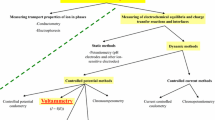Summary
The retention time of 11 ring-substituted phenol derivatives was measured on six different reversed-phase HPLC columns and the log k, theoretical plate number (N) and asymmetry factor (F) values were calculated for each solutes on each column. The similarities and dissimilarities among the columns and solutes were elucidated by principal component analysis followed with nonlinear mapping technique and cluster analysis. Calculations indicated that the retention characteristics of porous graphitized carbon stationary phase considerably deviate from those of octadecyl- and hexyl-coated silica, octadecyl-coated polystyrene-divinylbenzene polymer and polybutadiene-coated alumina. The differences among these columns were markedly smaller. The retention behaviour of aminophenols differed from those of other phenol derivatives proving the importance of molecular polarity in the retention. It was established that the mode of calculation slightly modifies the similarity and dissimilarity among the columns and solutes, therefore, the use of more than one calculation method is proposed.
Similar content being viewed by others
References
Hankey, R.A.; Addy, V.L.; Senior, K.; Langridge, D.A.; Bowden, W.; Scholz, W.J. Amer. Leather. Chem. Assoc. 2001,96, 205–213.
Gonzalez, G.; Herrera, G.; Garcia, M.T.; Pena, M.Biores. Technol. 2001,80, 137–142.
Mishra, S.; Singh, V.; Jain, A.; Verma, K.K.Analyst (Cambridge) 2001,126, 1663–1668.
Bastos, A.E.R.; Cassidy, M.B.; Trevors, J.T.; Lee, H.; Rossi, A.Appl. Microbiol. Biotechnol. 2001,56, 255–260.
Powley, M.W.; Carlson, G.P.Toxicol. Lett. 2001,125, 117–123.
Pedersen, G.; Brynskov, J.; Saermark, T.Scand. Gastroenter. 2002,37, 74–79.
Van Den Heuvel R.L.; Leppens, H.; Schoeters, G.E.R.Cell. Biol. Toxicol. 2001,17, 107–116.
Pessione, E.; Giuffrida, M.G.; Mazzoli, R.; Caposio, P.; Landolfo, S.; Conti, A.; Giunta, C.; Gribaudo, G.Biol. Chem. 2001,382, 1253–1261.
Helaleh, M.I.H.; Tanaka, K.; Fujii, S-I.; Korenaga, T.Anal. Sci. 2001,17, 1225–1227.
Sokolowksa-Wozniak, A.; Nowak, R.Herba Pol. 2000,46, 255–260.
Alons-Salces, R.M.; Korta, E.; Barranco, A.; Berrueta, L.A.; Gallo, B.; Vicente, F.J. Chromatogr. A 2001,933, 37–43.
Takeda, S.; Tanaka, Y.; Yamane, M.; Siroma, Z.; Wakida, S.; Otsuka, K.; Terabe, S.J. Chromatogr. A 2001,924, 415–420.
Mardia, K.V.; Kent, J.T.; Bibby, J.M.Multivariate Analysis. Academic Press, London,1979, pp. 213–254.
Drew, M.G.B.; Wilden, G.R.H.; Spillane, W.J.; Walsh, R.M.; Ryder, C.A.; Simmie, J.M.J. Agr. Food Chem. 1998,46, 3016–3026.
Seybold, P.G.SAR QSAR Environ. Res. 1999,10, 101–115.
Sarbu, C.; Todor, S.J. Planar Chromatogr. Mod. TLC 1998,11, 123–126.
Mannhold, R.; Cruciani, G.; Dross, K.; Rekker, R.J. Comp. Aid. Molec. Des. 1998,12, 573–581.
Héberger, K.; Lopata, A.J. Org. Chem. 1998,63, 8646–8653.
Héberger, K.; Görgényi, M.J. Chromatogr. A 1999,845, 21–31.
Damborsky, J.; Berglund, A.; Kuty, M.; Ansorgová, A.; Nagata, A.; Sjöström, M.Quant. Struc.-Act. Relat. 1998,17, 450–458.
Zaliani, A.; Gancia, E.J. Chem. Inf. Comput. Sci. 1999,39, 525–533.
Katritzky, A.R.; Tamm, T.; Wang, Y.; Karelson, M.J. Chem. Inf. Comput. Sci. 1999,39, 692–698.
Héberger, K.Chemon. Int. Lab. Syst. 1999,47, 41–49.
Dillon, W.R.Multivariate Analysis. John Wiley and Sons, New York,1984, pp. 213–254.
Sammon, J.W. Jr.IEEE Trans. Comput. 1969,C18, 401–407.
Forgács, E. Kósa, A.; Csiktusnádi Kiss, G.; Kaliszan, R.; Haber, P.; Nasal, A.J. Liq. Chrom. & Rel. Technol. 1998,21, 2523–2534.
Iványi, T.; Vander Heyden, Y.; Visky, D.; Baten, P.; De Beer, J.; Lázár, I.; Massart, D.L.; Roets, E.; Hoogmartens, J.J. Chromatogr. A 2002,954, 99–114.
Author information
Authors and Affiliations
Rights and permissions
About this article
Cite this article
Kánya, Z., Cserháti, T. & Forgács, E. Using principal component analysis for the study of the retention behaviour of phenol derivatives under reversed-phase conditions. Chromatographia 57, 451–456 (2003). https://doi.org/10.1007/BF02492540
Received:
Revised:
Accepted:
Issue Date:
DOI: https://doi.org/10.1007/BF02492540




